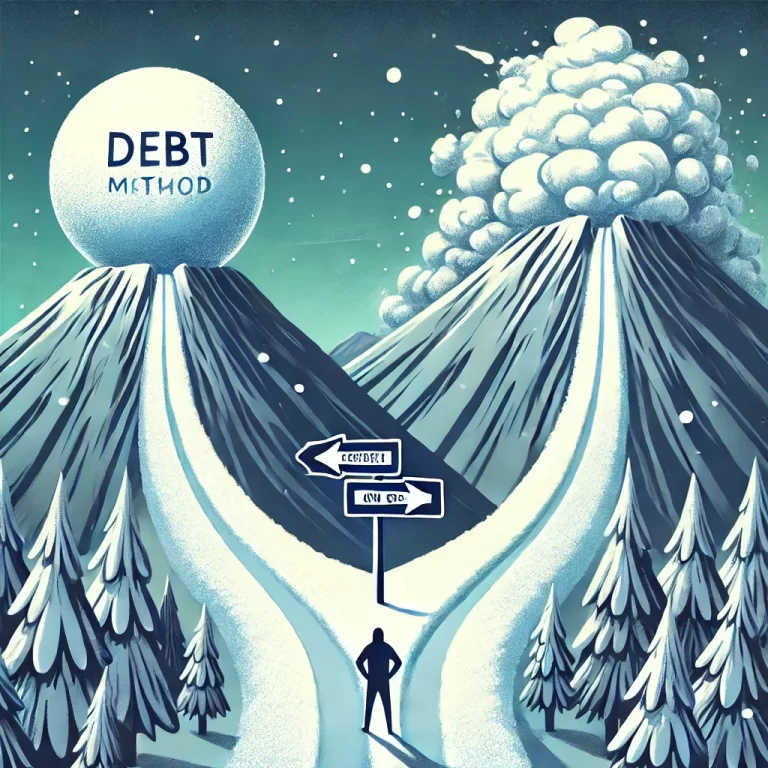The Snowball Method: Momentum Over Math
The Snowball Method, made famous by financial expert Dave Ramsey, focuses on building motivation by tackling small debts first. This strategy prioritizes psychological wins over economic efficiency.
How It Works:
- List all your debts from smallest to largest, ignoring interest rates.
- Make minimum payments on all debts except the smallest one.
- Put any extra money toward paying off the smallest debt first.
- Once the smallest debt is paid off, roll that payment into the next smallest debt.
- Repeat the process until you are debt-free.
Pros:
- Provides quick wins, keeping you motivated.
- It creates a substantial psychological boost as debts disappear.
- It helps develop disciplined financial habits.
Cons:
- It doesn’t focus on interest rates, so you might pay more in the long run.
- It may take longer if high-interest debts remain unpaid.
Example of the Snowball Method in Action:
Let’s say you have the following debts:
- Credit Card 1: $500 balance, 18% interest
- Medical Bill: $1,000 balance, 0% interest
- Credit Card 2: $3,000 balance, 22% interest
- Student Loan: $10,000 balance, 6% interest
Using the Snowball Method, you would first focus on the $500 credit card debt, regardless of its interest rate. You make minimum payments on all other debts and aggressively pay off Credit Card 1. Once that’s done, you move to the $1,000 medical bill, then Credit Card 2, and finally the Student Loan.
The Avalanche Method: Mathematically the Best Choice
The Avalanche Method prioritizes saving money by paying off the highest-interest debts first. This method is the fastest financially because it reduces the interest you pay over time.
How It Works:
- List all your debts from highest to lowest interest rate.
- Make minimum payments on all debts except the one with the highest interest rate.
- Put any extra money toward paying off the highest-interest debt first.
- Once that debt is gone, roll the payment into the next highest-interest debt.
- Continue the process until all debts are paid off.
Pros:
- Saves the most money on interest.
- Pays off debt faster than the Snowball Method in most cases.
- Maximizes financial efficiency.
Cons:
- It takes longer to see progress, which may be discouraging.
- Requires discipline to stick with the plan.
Example of the Avalanche Method in Action:
Using the same debts as before, here’s how the Avalanche Method would work:
- Credit Card 2: $3,000 balance, 22% interest (priority)
- Credit Card 1: $500 balance, 18% interest
- Student Loan: $10,000 balance, 6% interest
- Medical Bill: $1,000 balance, 0% interest
Instead of focusing on the smallest debt first, you would start with Credit Card 2 because it has the highest interest rate (22%). You make minimum payments on all other debts and throw any extra money at this one. Once it’s paid off, you move on to Credit Card 1 (18%), then the Student Loan (6%), and finally the Medical Bill (0%).
This strategy ensures that you eliminate high-interest debt quickly, saving you hundreds or even thousands in interest payments.
Which Method is Faster?
From a purely financial perspective, the Avalanche Method is the fastest way to pay off debt because it minimizes interest costs. Since tackling high-interest debt first, you pay less overall, making you debt-free sooner.
However, speed isn’t just about numbers, it is also about behavior and motivation. The Snowball Method can be faster in practice if it keeps you motivated to stay on track, especially if you struggle with debt repayment discipline.
Who Should Choose the Snowball Method?
- If you need quick motivation to stay committed.
- If you feel overwhelmed by debt and want to see progress fast.
- If you are more emotionally driven than mathematically focused.
Who Should Choose the Avalanche Method?
- If you want to pay off debt as quickly as possible while saving the most money.
- If you are disciplined and don’t need early wins to stay motivated.
- If you have large high-interest debts, that could cost you a lot over time.
Can You Combine Both Methods?
Yes! A hybrid approach can work if you want the best of both worlds. You can:
- Start with the Snowball Method to build momentum.
- Switch to the Avalanche Method once you’ve paid off several small debts.
This way, you get the psychological wins at the start and save money on interest in the long run.
Final Thoughts: Choose the Method That Works for You
At the end of the day, the best debt repayment method is the one you stick with. Whether you prefer the Snowball Method’s psychological motivation or the Avalanche Method’s financial efficiency, both strategies will help you achieve the same goal: becoming debt-free.
The key is to start today. Create your list of debts, choose your strategy, and commit to making consistent progress. No matter which path you take, the reward of financial freedom is worth it.



